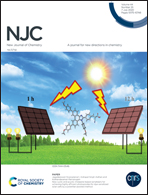Electronic structure and second-order nonlinear optical properties of linear [3]spirobifluorenylene compounds†
Abstract
Chiral organic compounds are excellent second-order nonlinear optical (NLO) materials due to their intrinsic asymmetric structures combined with the advantages of organic compounds. Here, based on linear [3]spirobifluorenylene, seven compounds are designed by introduction of donor/acceptor units and their combinations at different substituent positions. The ground state electronic structures, electronic transition, and second-order NLO properties of these compounds are fully investigated by DFT/TDDFT theory. The simulated electron absorption wavelengths and CD spectrum are in good agreement with the experimental ones, enabling us to fully specify the electronic transition properties and absolute configuration. It is found that the combination introduction of donor units and acceptor units is the most effective way to not only tune the energy gap and electron transition properties but also enhance the NLO response. For instance, the second-order NLO value of compound 8 is (109.76 × 10−30 esu) which is about 26 times larger than that of the highly π-delocalized phenyliminomethylferrocene complex, which is attributed to obvious charge transfer. In view of their large NLO response and intrinsic asymmetric structures, the studied compounds have the possibility to be excellent second-order NLO materials.
![Graphical abstract: Electronic structure and second-order nonlinear optical properties of linear [3]spirobifluorenylene compounds](/en/Image/Get?imageInfo.ImageType=GA&imageInfo.ImageIdentifier.ManuscriptID=D0NJ02454F&imageInfo.ImageIdentifier.Year=2020)


 Please wait while we load your content...
Please wait while we load your content...